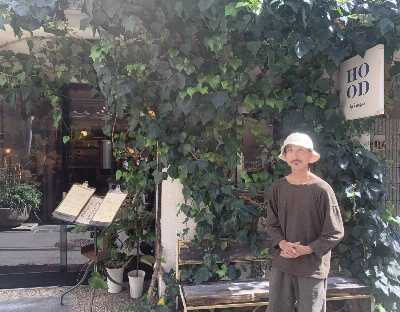By this time of year, with temperatures dropping fast and the wind whipping up, the leaves of deciduous trees have almost all fallen. I love to see them coming down, revealing intricate networks of boughs and branches.
Going home from school in Dublin as a child, I used to revel in running through the colorful piles of leaves from the sycamores (Acer pseudoplatanus) and horse chestnut trees (Aesculus hipposcastanum) in the fields beside the road.
Now, near my home in Hyogo, there is a nice mixed woodland where some deciduous oaks such as kunugi (Quercus acutissima) have reached their full height of 15-20 meters. Their straight, massive trunks have rough, thick, almost cork-textured bark that was once used as a substitute for true cork from Q. suber, which is native to southern Europe and North Africa.
Next time you are out for a stroll, look out for a kunugi to hug -- it's fun and will make you realize just how big trees are. While you're at it, search around for fallen kunugi leaves, which are oblong and 10-18 cm long, with 12-16 pairs of prominent veins that extend 2-3 mm beyond the leaf margin.
Around Tokyo there are many zoki-bayashi (coppiced woodlands), mainly comprising deciduous oaks such as kunugi and konara (Q. serrata). During the early Edo Period (1603-1867), the original dominant and slower-growing evergreen oaks were felled and replaced by fast-growing deciduous ones which, cut from carefully managed woodlands, were key sources of firewood and charcoal in the days before fossil fuels were widespread here.
With its high rainfall and long hot summers, Japan has one of the highest rates of woodland regrowth in the world. Hence, now that zoki-bayashi have become redundant as a source of fuel, evergreen oak seedlings are beginning to grow back in many areas. For a closer look at oaks (and much more) I would highly recommend a visit to the National Park for Nature Study in Tokyo's Meguro Ward.
But your enjoyment of trees and woodland plants doesn't have to be limited to parks and wide open spaces. Creating a garden with a woodland atmosphere is not so difficult -- even if your garden is restricted to pots on a balcony.
Whatever its scale, every woodland garden should have a yatsude (Japanese aralia; Fatsia japonica), which belongs to the ginseng family (Araliaceae), of which ivy is another member. Yatsude is a plant of warm-temperate regions and can be seen growing in woodlands and on hills along Japan's Pacific coastline from Ibaraki Prefecture through to Kyushu.
Yatsude is an evergreen shrub 1-3 meters high, with palmate leaves 20-40 cm across and with seven to nine lobes each. Their leathery texture and shiny upper surfaces are adaptations to withstand salty air. Western landscape designers regard yatsude as an "architectural" plant, and cultivars are available with white or yellow variegations.
The shrub's white, monecious flowers -- meaning (male) stamens and (female) pistils are on separate blooms -- are in terminal umbels from November through December. The fruit is a black drupe -- a seed surrounded by a fleshy part and a skin -- 7-10 mm in diameter, which birds love to devour, thereby helping seed dispersal.
In the woods you may also come across two evergreen sub-shrubs with bright red berries. Yabukoji (Ardisia japonica) is a subterranean-stemmed plant (stoloniferous) which grows to only 10-20 cm. However, in the Edo Period, yabukoji and many other native plants were popular with gardeners. As a result, numerous cultivars were raised -- some with cristate leaves; others variegated -- and around now you may find some of them in your local garden center.
Manryo (A. crenata) is a taller (30-100 cm) cousin of yabukoji, also evergreen, and like yabukoji has many cultivars dating back to the Edo Period. Berried plants in pots are used as good-luck decoration around New Year, and my favorite is the yellow-berried manryo (kimi-manryo), whose leaves are opposite, 4-13 cm long and with undulated margins. Inconspicuous white flowers from July to August are followed by small red berries from around now until April.
Senryo (Chloranthus glaber) is another warm-temperate, low-growing (50-100 cm) evergreen shrub in woodlands in the Tokaido region, the Izu peninsula and westward through Honshu to Okinawa and East Asia. With alternate, 10-15 cm oblong leaves with sharply serrated margins, it bears bisexual flowers during the rainy season, and small (5-7 mm) berries that ripen between December and March. There are only a few cultivars, but the yellow-berried senryo is popular.
Though manryo and senryo are similar, it's easy to tell them apart because the manryo's berries hang down, and the senryo's face up.
Another, larger, evergreen shrub you may encounter on a woodland walk is the aoki (spotted laurel; Aucuba japonica), which can reach up to 2-3 meters high and is a favorite of gardeners in both Japan and the West. This green-leafed laurel grows in open woodlands from southern Hokkaido to Okinawa. Its male and female flowers are borne on separate plants between March and May, and if the female flowers are pollinated with male pollen then attractive oval-shaped red berries 1.5-2 cm long are produced between December and May. Occasionally, yellow-berried kimi-aoki or white-fruited shiro-aoki may spontaneously arise.
Meanwhile, the Sea of Japan side of Honshu, where annual snowfall is heavy, is where to go to find the low-growing, hardy laurel hime-aoki (A. japonica var. borealis), which can grow to a meter high.
But remember, all these plants can be grown in pots or shady spots in your garden. Just be sure their well-drained soil is rich in leaf mold . . . then enjoy your own stand of native shrubs.

















With your current subscription plan you can comment on stories. However, before writing your first comment, please create a display name in the Profile section of your subscriber account page.